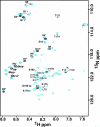A solution NMR investigation into the murine amelogenin splice-variant LRAP (Leucine-Rich Amelogenin Protein)
- PMID: 20304108
- PMCID: PMC2910175
- DOI: 10.1016/j.bbapap.2010.03.006
A solution NMR investigation into the murine amelogenin splice-variant LRAP (Leucine-Rich Amelogenin Protein)
Abstract
Amelogenins are the dominant proteins present in ameloblasts during the early stages of enamel biomineralization, making up >90% of the matrix protein. Along with the full-length protein there are several splice-variant isoforms of amelogenin present including LRAP (Leucine-Rich Amelogenin Protein), a protein that consists of the first 33 and the last 26 residues of full-length amelogenin. Using solution-state NMR spectroscopy we have assigned the (1)H-(15)N HSQC spectrum of murine LRAP (rp(H)LRAP) in 2% acetic acid at pH 3.0 by making extensive use of previous chemical shift assignments for full-length murine amelogenin (rp(H)M180). This correlation was possible because LRAP, like the full-length protein, is intrinsically disordered under these solution conditions. The major difference between the (1)H-(15)N HSQC spectra of rp(H)M180 and rp(H)LRAP was an additional set of amide resonances for each of the seven non-proline residues between S12 and Y12 near the N-terminus of rp(H)LRAP indicating that the N-terminal region of LRAP exists in two different conformations. Analysis of the proline carbon chemical shifts suggests that the molecular basis for the two states is not a cis-trans isomerization of one or more of the proline residues in the N-terminal region. Starting from 2% acetic acid, where rp(H)LRAP was monomeric in solution, NaCl addition effected residue specific changes in molecular dynamics manifested by the reduction in intensity and disappearance of (1)H-(15)N HSQC cross peaks. As observed for the full-length protein, these perturbations may signal early events governing supramolecular self-assembly of rp(H)LRAP into nanospheres. However, the different patterns of (1)H-(15)N HSQC cross peak perturbation between rp(H)LRAP and rp(H)M180 in high salt suggest that the termini may behave differently in their respective nanospheres, and perhaps, these differences contribute to the cell signaling properties attributable to LRAP but not to the full-length protein.
Copyright © 2010 Elsevier B.V. All rights reserved.
Figures




Similar articles
-
A solution NMR investigation into the impaired self-assembly properties of two murine amelogenins containing the point mutations T21→I or P41→T.Arch Biochem Biophys. 2013 Sep 15;537(2):217-24. doi: 10.1016/j.abb.2013.07.015. Epub 2013 Jul 26. Arch Biochem Biophys. 2013. PMID: 23896516 Free PMC article.
-
A solution NMR investigation into the early events of amelogenin nanosphere self-assembly initiated with sodium chloride or calcium chloride.Biochemistry. 2008 Dec 16;47(50):13215-22. doi: 10.1021/bi8018288. Biochemistry. 2008. PMID: 19086270 Free PMC article.
-
The leucine-rich amelogenin protein (LRAP) is primarily monomeric and unstructured in physiological solution.J Struct Biol. 2015 Apr;190(1):81-91. doi: 10.1016/j.jsb.2014.10.007. Epub 2014 Oct 25. J Struct Biol. 2015. PMID: 25449314 Free PMC article.
-
Controls of nature: Secondary, tertiary, and quaternary structure of the enamel protein amelogenin in solution and on hydroxyapatite.J Struct Biol. 2020 Dec 1;212(3):107630. doi: 10.1016/j.jsb.2020.107630. Epub 2020 Sep 24. J Struct Biol. 2020. PMID: 32979496 Free PMC article. Review.
-
Amelogenin proteins of developing dental enamel.Ciba Found Symp. 1997;205:118-30; discussion 130-4. doi: 10.1002/9780470515303.ch9. Ciba Found Symp. 1997. PMID: 9189621 Review.
Cited by
-
Folding and self-assembly of short intrinsically disordered peptides and protein regions.Nanoscale Adv. 2021 Jan 18;3(7):1789-1812. doi: 10.1039/d0na00941e. eCollection 2021 Apr 6. Nanoscale Adv. 2021. PMID: 36133101 Free PMC article. Review.
-
Cryogenic transmission electron microscopy study of amelogenin self-assembly at different pH.Cells Tissues Organs. 2011;194(2-4):166-70. doi: 10.1159/000324250. Epub 2011 May 20. Cells Tissues Organs. 2011. PMID: 21597263 Free PMC article.
-
A solution NMR investigation into the impaired self-assembly properties of two murine amelogenins containing the point mutations T21→I or P41→T.Arch Biochem Biophys. 2013 Sep 15;537(2):217-24. doi: 10.1016/j.abb.2013.07.015. Epub 2013 Jul 26. Arch Biochem Biophys. 2013. PMID: 23896516 Free PMC article.
-
Improved protocol to purify untagged amelogenin - Application to murine amelogenin containing the equivalent P70→T point mutation observed in human amelogenesis imperfecta.Protein Expr Purif. 2015 Jan;105:14-22. doi: 10.1016/j.pep.2014.09.020. Epub 2014 Oct 13. Protein Expr Purif. 2015. PMID: 25306873 Free PMC article.
-
Protein Phosphorylation and Mineral Binding Affect the Secondary Structure of the Leucine-Rich Amelogenin Peptide.Front Physiol. 2017 Jun 29;8:450. doi: 10.3389/fphys.2017.00450. eCollection 2017. Front Physiol. 2017. PMID: 28706493 Free PMC article.
References
-
- Ten Cate AR. Oral histology: developement, structure, and function. 4th ed. Mosby; St. Louis: 1994.
-
- White SN, Luo W, Paine ML, Fong H, Sarikaya M, Snead ML. Biological organization of hydroxyapatite crystallites into a fibrous continuum toughens and controls anisotrophy in human enamel. J. Dent. Res. 2001;80:321–326. - PubMed
-
- Hunter G. Interfacial aspects of biomineralization. Curr. Opin. Mat. Sci. 1996;1:430–435.
-
- Margolis HC, Beniash E, Fowler CE. Role of macromoleculare assembly of enamel matrix proteins in enamel formation. Crit. Rev. Oral Biol. Med. 2006;85:775–793. - PubMed
-
- Termine JD, Belcourt AB, Christner PJ, Conn KM, Nylen MU. Properties of dissociatively extracted fetal tooth matrix proteins. J. Biol. Chem. 1990;255:9760–9768. - PubMed
Publication types
MeSH terms
Substances
Grants and funding
LinkOut - more resources
Full Text Sources
Molecular Biology Databases
Research Materials

